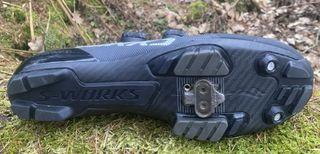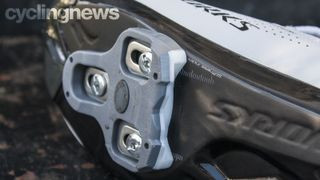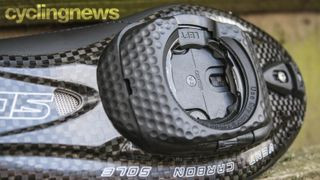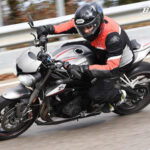Do All Road Bike Shoes Fit All Pedals? Not necessarily. The compatibility between road bike shoes and pedals depends on the cleat system they use. This usabikers.net guide will explore the different cleat systems, their compatibility, and how to choose the right combination for optimal performance and comfort on your rides. Understanding these nuances ensures you maximize your power transfer, efficiency, and overall riding experience.
1. Understanding Cleats and Clipless Pedals
1.1. What are Clipless Pedals?
Clipless pedals are a type of bicycle pedal that requires a special cycling shoe with a cleat attached to the sole. Unlike flat pedals, which allow your feet to float freely, clipless pedals create a secure connection between your foot and the pedal. The term “clipless” is a bit of a misnomer, as it refers to the absence of toe clips, which were used to secure feet to pedals before the advent of clipless systems.
1.2. What are Cleats?
Cleats are the component that attaches to the bottom of your cycling shoe and interfaces with the clipless pedal. They are designed to lock into the pedal mechanism, providing a secure and efficient connection. Different pedal systems use different cleat designs, and these cleats are not interchangeable between systems.
1.3. The Benefits of Using Cleats and Clipless Pedals
- Increased Efficiency: Clipless pedals allow you to engage more muscles throughout the pedal stroke, including the upstroke, resulting in greater power output and efficiency. According to a study by the Journal of Science and Medicine in Sport, cyclists using clipless pedals demonstrated a 7% increase in power output compared to those using flat pedals.
- Enhanced Control: By securing your feet to the pedals, clipless systems provide better control over the bike, especially during sprints, climbs, and technical maneuvers.
- Consistent Foot Placement: Cleats ensure that your feet are always in the optimal position on the pedals, reducing the risk of injury and improving comfort over long rides.
- Improved Safety: Although it may seem counterintuitive, clipless pedals can enhance safety by preventing your feet from slipping off the pedals, particularly in wet or bumpy conditions.
 The sole of a Specialized S-Works Recon shoe showing the SPD cleat beneath
The sole of a Specialized S-Works Recon shoe showing the SPD cleat beneath
The image shows a Specialized S-Works Recon shoe with SPD cleat, optimal for mountain biking and all-terrain riding, providing secure and efficient pedal connection.
2. Types of Cycling Cleats
2.1. SPD (Shimano Pedaling Dynamics)
2.1.1. Overview of SPD Cleats
SPD cleats are a two-bolt system primarily designed for mountain biking, touring, and indoor cycling. They feature a smaller cleat that is recessed into the sole of the shoe, making them easier to walk in.
2.1.2. Advantages of SPD Cleats
- Durability: SPD cleats are built to withstand the rigors of off-road riding, making them highly durable and resistant to wear and tear.
- Ease of Use: The two-bolt design makes SPD cleats easy to clip in and out of, which is especially beneficial for beginners and riders who frequently stop and start.
- Walkability: The recessed cleat design allows for more natural walking, making SPD shoes a practical choice for activities beyond cycling.
2.1.3. Disadvantages of SPD Cleats
- Smaller Contact Point: Compared to road-specific cleats, SPD cleats have a smaller contact point with the pedal, which can result in slightly less efficient power transfer.
- Less Stability: The smaller platform of SPD pedals may not provide the same level of stability as larger road pedals, particularly during high-intensity efforts.
2.2. Look Keo Cleats
2.2.1. Overview of Look Keo Cleats
Look Keo cleats are a three-bolt system designed specifically for road cycling. They offer a wider platform for increased stability and power transfer.
2.2.2. Advantages of Look Keo Cleats
- Maximum Power Transfer: Look Keo cleats provide a large contact area with the pedal, maximizing power transfer and efficiency.
- Stability: The wide platform of Look Keo pedals offers excellent stability, allowing riders to maintain a solid connection with the bike during sprints and climbs.
- Adjustable Float: Look Keo cleats are available in different float options (0, 4.5, or 9 degrees), allowing riders to customize the amount of lateral movement in their pedal stroke.
2.2.3. Disadvantages of Look Keo Cleats
- Difficult to Walk In: Look Keo cleats protrude from the sole of the shoe, making them awkward and slippery to walk in.
- Less Durable: Compared to SPD cleats, Look Keo cleats are more susceptible to wear and tear, especially when walking on rough surfaces.
 The sole of a Specialized S-Works Ares road shoe with Look Keo Cleat fitted
The sole of a Specialized S-Works Ares road shoe with Look Keo Cleat fitted
Specialized S-Works Ares road shoe with Look Keo Cleat, excellent for track cyclists, provides optimal power transfer but can be slippery and difficult to walk in.
2.3. SPD-SL Cleats
2.3.1. Overview of SPD-SL Cleats
SPD-SL cleats are Shimano’s road-specific three-bolt system, designed to compete with Look Keo. They offer a wide platform and secure engagement for efficient power transfer.
2.3.2. Advantages of SPD-SL Cleats
- Wide Platform: SPD-SL cleats provide a broad contact area with the pedal, enhancing stability and power transfer.
- Secure Engagement: The robust locking mechanism of SPD-SL pedals ensures a secure connection between the shoe and pedal.
- Adjustable Float: Like Look Keo cleats, SPD-SL cleats are available in different float options (0, 2, or 6 degrees) to accommodate individual preferences and biomechanics.
2.3.3. Disadvantages of SPD-SL Cleats
- Walking Difficulty: SPD-SL cleats are not designed for walking and can be slippery and uncomfortable when off the bike.
- Stiffness: The stiff construction of SPD-SL cleats can be unforgiving for some riders, particularly on long rides.
 The sole of a Specialized S-Works Vent shoe with Shimano SPD SL cleat fitted
The sole of a Specialized S-Works Vent shoe with Shimano SPD SL cleat fitted
The image displays a Specialized S-Works Vent shoe with Shimano SPD SL cleat, ensuring a comfortable feel and efficient power transfer for cyclists.
2.4. Wahoo Speedplay Cleats
2.4.1. Overview of Wahoo Speedplay Cleats
Wahoo Speedplay cleats are a unique four-bolt system known for their adjustability and dual-sided entry. They offer a high degree of float and customizable engagement.
2.4.2. Advantages of Wahoo Speedplay Cleats
- Dual-Sided Entry: Speedplay pedals can be clipped into from either side, making them easy to use and convenient for quick starts.
- Adjustable Float: Speedplay cleats offer the largest range of float adjustment (0-15 degrees), allowing riders to fine-tune their pedal stroke for optimal comfort and efficiency.
- Lightweight: Speedplay pedals and cleats are typically lighter than other systems, which can be an advantage for competitive cyclists.
2.4.3. Disadvantages of Wahoo Speedplay Cleats
- Maintenance: Speedplay pedals require regular lubrication to maintain smooth operation and prevent premature wear.
- Cost: Speedplay pedals and cleats tend to be more expensive than other systems.
- Walking Difficulty: Similar to other road-specific cleats, Speedplay cleats are not ideal for walking.
 The sole of a Sidi shoe with Wahoo Speedplay cleat fitted
The sole of a Sidi shoe with Wahoo Speedplay cleat fitted
The sole of a Sidi shoe with Wahoo Speedplay cleat highlights their adjustability and dual-sided entry, making them suitable for road cycling.
2.5. Crankbrothers Cleats
2.5.1. Overview of Crankbrothers Cleats
Crankbrothers cleats use the “Eggbeater” style and are primarily designed for mountain biking and cyclocross. They are known for their mud-shedding ability and easy entry and exit.
2.5.2. Advantages of Crankbrothers Cleats
- Mud Shedding: The open design of Crankbrothers pedals allows mud and debris to pass through easily, making them ideal for off-road riding.
- Easy Entry and Exit: Crankbrothers cleats offer a low pedal tension, making them easy to clip in and out of, even in challenging conditions.
- Four-Sided Entry: Crankbrothers pedals can be clipped into from all four sides, providing maximum convenience and versatility.
2.5.3. Disadvantages of Crankbrothers Cleats
- Less Secure: The low pedal tension of Crankbrothers pedals may not provide the same level of security as other systems, particularly during high-intensity efforts.
- Durability: Crankbrothers cleats and pedals may not be as durable as other options, especially when subjected to frequent use in harsh conditions.
The image features four Crankbrothers cleats, showcasing their mud-shedding ability and easy entry and exit, perfect for mountain biking and cyclo-cross.
3. Road Bike Shoe and Pedal Compatibility
3.1. Three-Bolt vs. Two-Bolt Systems
The primary factor determining compatibility between road bike shoes and pedals is the bolt pattern on the sole of the shoe. Road-specific shoes typically have a three-bolt pattern, while mountain bike and touring shoes usually have a two-bolt pattern.
- Three-Bolt Systems: Look Keo and Shimano SPD-SL are the most common three-bolt systems. Shoes designed for these systems have three threaded holes in a triangular pattern on the sole.
- Two-Bolt Systems: Shimano SPD is the most common two-bolt system. Shoes designed for this system have two threaded holes parallel to each other on the sole.
3.2. Adapters
In some cases, it is possible to use adapters to mount three-bolt cleats on shoes with a two-bolt pattern, or vice versa. However, these adapters can add extra height and weight, and they may not provide the same level of security and stability as a direct connection.
3.3. Universal Compatibility
Some shoe manufacturers offer models with both three-bolt and two-bolt patterns on the sole, providing greater versatility and compatibility with different pedal systems. These shoes are a good option for riders who use multiple types of bikes or pedals.
4. How to Choose the Right Combination
4.1. Consider Your Riding Style
The type of riding you do will influence your choice of shoes and pedals.
- Road Cycling: For road cycling, a three-bolt system like Look Keo or Shimano SPD-SL is generally preferred for its superior power transfer and stability.
- Mountain Biking: For mountain biking, a two-bolt system like Shimano SPD or Crankbrothers is recommended for its durability, mud-shedding ability, and ease of use.
- Touring: For touring, a two-bolt system like Shimano SPD is a good choice for its walkability and versatility.
- Indoor Cycling: For indoor cycling, either a two-bolt or three-bolt system can be used, depending on the type of pedals on the bike.
4.2. Prioritize Comfort
Comfort is essential, especially for long rides. Consider the following factors:
- Shoe Fit: Choose shoes that fit well and provide adequate support for your feet.
- Float: Experiment with different float options to find the amount of lateral movement that feels most comfortable and natural for your pedal stroke.
- Cleat Position: Properly position your cleats to ensure optimal alignment and prevent knee pain or other injuries.
4.3. Set Up Cycling Cleats
You’ve got your new cleats and your new pair of shoes, and you’re sitting at the workbench, ready to attach them. But where do they go?
The obvious answer here is the bottom of your shoe, but there are a few nuances to ensuring you get them in the correct position, and with two-bolt cleats, ensure you get them the correct way round. Fortunately, mounting cleats does not need to be complicated and all brands include a basic guide to fitment.
As for position, many, including myself, believe that best practice is mounting your cleats in the middle (both vertically and horizontally) of the ball of your foot, and adjusting from there. Common practice, as outlined in our bike fit guide, is to get the axle of the pedal directly beneath the ball of your foot. So to achieve this, here are a few ways you can test and adjust your cleat placement to simultaneously maximize comfort and power transfer.
There are five main ways you can adjust your cleats: fore and aft (closer to toe or heel), side-to-side, rotationally, float, and pedal tension.
Before you make any adjustments, remember that just because you’re adjusting one cleat doesn’t mean that you have to adjust the other. A lot of us have minor abnormalities, such as a leg length discrepancy, or rotated hips. Sometimes a unilateral adjustment is all you need because it will put you right back in alignment. A shim is a popular cleat adjustment, which involves placing a thin piece of material on one of your cleats, between the sole of the shoe and the cleat itself. This can add 0.1cm or 0.5cm of height to one side, which can help balance out any discrepancies.
Fore and aft and side-to-side adjustments mostly come down to personal preference and anatomical necessity. A bike fit is one of the best ways to ensure you get your cleat position right whilst maintaining suitable knee and hip angles.
As we’ve mentioned, a small degree of float is good for most cyclists as it allows your knee to bend and flex in a more natural and fluid way than straight up and down. Many cleat manufacturers will set limits on the degree of float allowed in their cleats, so make sure you read the fine print before making the final purchase. Look and Shimano even have colour-coded cleats to designate its degree of float.
As always, a professional bike fitter will be able to help with your cleat adjustment, as well as your overall riding position. Remember that your cleat position and height will affect your riding position, and especially your saddle height. New cleats can add 1-2cm of height onto the bottom of your foot, which will change your riding position if you don’t adjust your saddle height. So remember to tweak your riding position as a whole if and when you make any adjustments to your cleats.
4.4. Consider Your Budget
The cost of shoes and pedals can vary widely. Set a budget and choose the best combination that meets your needs without breaking the bank.
5. Pros and Cons of Cycling with Cleats
5.1. Pros of Cycling with Cleats
- Increased Efficiency: Cleats allow you to engage more muscles throughout the pedal stroke, resulting in greater power output and efficiency.
- Enhanced Control: By securing your feet to the pedals, cleats provide better control over the bike, especially during sprints, climbs, and technical maneuvers.
- Consistent Foot Placement: Cleats ensure that your feet are always in the optimal position on the pedals, reducing the risk of injury and improving comfort over long rides.
5.2. Cons of Cycling with Cleats
- Learning Curve: It can take some time to get used to clipping in and out of clipless pedals, and there is a risk of falling over when you first start using them.
- Walking Difficulty: Road-specific cleats are not designed for walking and can be slippery and uncomfortable when off the bike.
- Cost: Clipless pedals and shoes can be more expensive than flat pedals and regular shoes.
6. Maintaining Your Cleats and Pedals
6.1. Regular Cleaning
Keep your cleats and pedals clean to ensure smooth engagement and prevent premature wear. Use a brush and mild soap to remove dirt and debris.
6.2. Lubrication
Lubricate your pedals regularly to keep them spinning smoothly and prevent rust. Use a bike-specific lubricant and apply it to the moving parts of the pedal.
6.3. Cleat Replacement
Replace your cleats when they become worn or damaged. Worn cleats can be difficult to clip in and out of, and they may not provide a secure connection with the pedal.
7. Addressing Common Challenges
7.1. Difficulty Clipping In/Out
If you’re having trouble clipping in or out of your pedals, try the following:
- Adjust the Tension: Most clipless pedals have adjustable tension. Loosen the tension to make it easier to clip in and out, or tighten it for a more secure connection.
- Practice: Practice clipping in and out while stationary to get a feel for the mechanism.
- Check Cleat Position: Ensure that your cleats are properly positioned on your shoes.
7.2. Knee Pain
Knee pain is a common issue among cyclists, and it can often be traced back to improper cleat alignment. If you’re experiencing knee pain, consider the following:
- Adjust Cleat Position: Experiment with different cleat positions to find the optimal alignment for your knees.
- Consider Float: Use cleats with adjustable float to allow for more natural movement of your knees.
- Seek Professional Help: Consult a bike fitter or physical therapist for assistance with cleat alignment and bike fit.
8. Real-World Examples and Case Studies
8.1. Case Study 1: Road Cyclist with Knee Pain
A road cyclist was experiencing persistent knee pain despite trying various cleat positions. After consulting a bike fitter, it was discovered that the cyclist had a leg length discrepancy. Shims were added to the shorter leg to equalize the leg lengths, and the cleat position was adjusted accordingly. The knee pain resolved, and the cyclist was able to ride comfortably again.
8.2. Case Study 2: Mountain Biker with Muddy Conditions
A mountain biker was struggling with clipping in and out of their pedals in muddy conditions. They switched to Crankbrothers pedals and cleats, which are known for their mud-shedding ability. The problem was solved, and the rider was able to ride confidently in all conditions.
9. Expert Opinions and Recommendations
9.1. Professional Bike Fitters
Professional bike fitters recommend choosing shoes and pedals that are appropriate for your riding style and biomechanics. They also emphasize the importance of proper cleat alignment to prevent injuries and maximize performance.
9.2. Cycling Coaches
Cycling coaches advise riders to experiment with different cleat positions and float options to find the setup that feels most comfortable and efficient. They also recommend regular maintenance of cleats and pedals to ensure smooth operation and prevent premature wear.
10. Conclusion: Optimizing Your Road Bike Setup
Choosing the right combination of road bike shoes and pedals is crucial for maximizing your performance, comfort, and safety. While not all road bike shoes fit all pedals due to varying cleat systems, understanding the nuances of each system and considering your riding style, comfort preferences, and budget will enable you to make an informed decision.
Remember to prioritize proper cleat alignment and regular maintenance to ensure a smooth and enjoyable riding experience. For more information, visit usabikers.net to discover more tips, reviews, and community discussions on optimizing your biking experience. Don’t forget to explore our forums and share your experiences with fellow bike enthusiasts!
Ready to take your cycling to the next level? Explore usabikers.net today for expert advice, gear reviews, and a vibrant community of fellow riders!
Address: 801 Sturgis Main St, Sturgis, SD 57785, United States
Phone: +1 (605) 347-2000
Website: usabikers.net
11. FAQs About Road Bike Shoes and Pedals
11.1. Can I use mountain bike shoes with road bike pedals?
No, mountain bike shoes with two-bolt cleats are generally not compatible with road bike pedals, which use a three-bolt system.
11.2. Are all three-bolt cleats the same?
While most three-bolt cleats follow a standard pattern, there may be slight variations between brands, so it’s best to stick with cleats from the same manufacturer as your pedals.
11.3. How often should I replace my cleats?
Depending on usage and walking frequency, cleats should be replaced every 3-12 months or when they show signs of significant wear.
11.4. What does “float” mean in the context of cycling cleats?
Float refers to the degree of rotational movement allowed while clipped into the pedal, providing comfort and reducing strain on your knees.
11.5. Can I adjust the tension on my clipless pedals?
Yes, most clipless pedals have adjustable tension settings to customize how easily you clip in and out.
11.6. Why are road bike shoes so stiff?
Road bike shoes are designed with stiff soles to maximize power transfer from your legs to the pedals, enhancing efficiency.
11.7. Is it normal to fall over when starting out with clipless pedals?
Yes, it’s common to experience a few falls when learning to use clipless pedals. Practice in a safe area until you become comfortable.
11.8. Can I walk comfortably in road bike shoes?
Road bike shoes are not designed for comfortable walking, as the cleats protrude from the sole. Consider using shoe covers for short walks.
11.9. How do I prevent my cleats from squeaking?
Apply a small amount of Teflon-based lubricant to the contact points between the cleat and pedal to prevent squeaking.
11.10. What are the best socks to wear with road bike shoes?
Choose thin, moisture-wicking socks made from materials like merino wool or synthetic fibers to keep your feet dry and comfortable.

